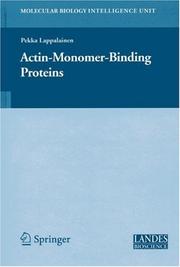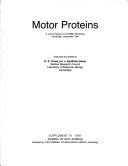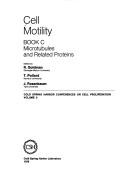| Listing 1 - 10 of 18 | << page >> |
Sort by
|
Book
ISBN: 0436273268 Year: 1978 Publisher: London Secker and Warburg
Abstract | Keywords | Export | Availability | Bookmark
 Loading...
Loading...Choose an application
- Reference Manager
- EndNote
- RefWorks (Direct export to RefWorks)
792.028 --- Actin --- Actomyosin --- Theateropvoering. Theatervoorstelling --- Acting. --- 792.028 Theateropvoering. Theatervoorstelling --- Acting --- Histrionics --- Stage --- Elocution --- Theater
Book
ISBN: 9781621003021 1621003027 9781621001911 1621001911 Year: 2012 Publisher: New York
Abstract | Keywords | Export | Availability | Bookmark
 Loading...
Loading...Choose an application
- Reference Manager
- EndNote
- RefWorks (Direct export to RefWorks)
Actin --- Tumors --- Respiratory infections --- Actomyosin --- Respiratory organs --- Respiratory tract infections --- Upper respiratory infections --- Upper respiratory tract infections --- Infection --- Neoplasms --- Tumours --- Pathology --- Cysts (Pathology) --- Oncology --- Physiology. --- Ultrastructure. --- Pathophysiology. --- Infections --- Diseases --- Actins

ISBN: 1281512982 9786611512989 0387464077 0387464050 Year: 2007 Publisher: New York, NY : Springer New York : Imprint: Springer,
Abstract | Keywords | Export | Availability | Bookmark
 Loading...
Loading...Choose an application
- Reference Manager
- EndNote
- RefWorks (Direct export to RefWorks)
The actin cytoskeleton plays a central role in many cellular processes including cell motility, cytokinesis, endocytosis and phagocytosis. The structure and dynamics of the actin cytoskeleton is regulated by a large number of proteins that interact with monomeric and/or filamentous actin. Actin monomer binding proteins provides a comprehensive view on actin monomer-binding proteins and the mechanisms by which they contribute to actin dynamics and various actin-dependent cellular processes. This new title contains chapters that describe the basic mechanisms of actin dynamics as well as the structural principles by which various actin-binding proteins interact with actin.
Actin. --- Carrier proteins. --- Binding proteins --- Transport proteins --- Biological transport --- Protein binding --- Proteins --- Actomyosin --- Cytology. --- Biochemistry. --- Cell Biology. --- Biochemistry, general. --- Biological chemistry --- Chemical composition of organisms --- Organisms --- Physiological chemistry --- Biology --- Chemistry --- Medical sciences --- Cell biology --- Cellular biology --- Cells --- Cytologists --- Composition --- Cell biology.

ISBN: 0948601299 9780948601293 Year: 1991 Volume: 14 Publisher: Cambridge The Company of biologists limited
Abstract | Keywords | Export | Availability | Bookmark
 Loading...
Loading...Choose an application
- Reference Manager
- EndNote
- RefWorks (Direct export to RefWorks)
Cytoskeletal Proteins. --- Muscle Proteins. --- Nervous System --- Muscle proteins --- -Membrane proteins --- -Tubulins --- -Microtubule proteins --- Tubulin --- Microtubules --- Proteins --- Membranes (Biology) --- Muscle Protein --- Protein, Muscle --- Proteins, Muscle --- Proteins, Cytoskeletal --- Cytoskeleton --- cytology. --- metabolism. --- Congresses --- Actomyosin --- Membrane proteins --- Tubulins --- CYTOSKELETAL PROTEINS --- MUSCLE PROTEINS --- NERVOUS SYSTEM, cytology --- NERVOUS SYSTEM, metabolism --- Congresses. --- -cytology. --- Cytoskeletal proteins --- Nervous system, cytology --- Nervous system, metabolism --- Cytoskeletal Proteins --- Muscle Proteins --- Microtubule proteins --- cytology --- metabolism --- Motor proteins
Book
ISBN: 9811374503 981137449X Year: 2019 Publisher: Singapore : Springer Singapore : Imprint: Springer,
Abstract | Keywords | Export | Availability | Bookmark
 Loading...
Loading...Choose an application
- Reference Manager
- EndNote
- RefWorks (Direct export to RefWorks)
This book discusses in detail the structural, evolutionary and functional role of actin and its regulatory proteins in gliding motility in apicomplexan organisms, a unique phenomenon found in actin-myosin cytoskeletal elements. The book also explores the potential of different actin regulators, namely formin, profilin, actin depolymerization factor (ADF), capping proteins (CPα and CPβ), cyclase-associated protein (CAP) and coronin 13–24 as potential drug targets against malaria. As the chief components of the gliding motor, the actin-regulator proteins are characterized by unique features that make them promising targets for structure-based drug design. Lastly, the book proposes a mathematical model, based on kinetic data mining, to help understand the most vital regulators for actin polymerization dynamics.
Parasitology. --- Biomechanics. --- Proteins . --- Bioinformatics. --- Protein Science. --- Protein Structure. --- Bio-informatics --- Biological informatics --- Biology --- Information science --- Computational biology --- Systems biology --- Proteids --- Biomolecules --- Polypeptides --- Proteomics --- Biological mechanics --- Mechanical properties of biological structures --- Biophysics --- Mechanics --- Contractility (Biology) --- Data processing --- Actin. --- Actomyosin --- Enginyeria de proteïnes --- Disseny de proteïnes --- Tecnologia de proteïnes --- Enginyeria bioquímica --- Enginyeria genètica
Book
ISBN: 0720406161 9780720406160 Year: 1976 Publisher: Amsterdam North-Holland
Abstract | Keywords | Export | Availability | Bookmark
 Loading...
Loading...Choose an application
- Reference Manager
- EndNote
- RefWorks (Direct export to RefWorks)
Animal physiology. Animal biophysics --- Human biochemistry --- Myosin --- Cells --- Actin --- Contractile Proteins --- Cell Movement --- Muscle, Smooth --- Congresses --- Contraction --- physiology --- Cell Movement. --- -Cells --- -Myosin --- -Microfilament proteins --- Muscle proteins --- Organisms --- Cytology --- Actomyosin --- Cell Migration --- Locomotion, Cell --- Migration, Cell --- Motility, Cell --- Movement, Cell --- Cell Locomotion --- Cell Motility --- Cell Movements --- Movements, Cell --- Cell Tracking --- physiology. --- -Congresses --- Cell movement --- Congresses. --- -physiology. --- Microfilament proteins --- Contraction&delete& --- Myosin - Congresses --- Cells - Contraction - Congresses --- Actin - Congresses --- Contractile Proteins - physiology - congresses --- Cell Movement - congresses --- Muscle, Smooth - physiology - congresses
Book
ISBN: 9048193001 9786612994647 904819301X 1282994646 9400796404 Year: 2010 Publisher: New York : Springer,
Abstract | Keywords | Export | Availability | Bookmark
 Loading...
Loading...Choose an application
- Reference Manager
- EndNote
- RefWorks (Direct export to RefWorks)
This book presents the cellular, molecular and physical aspects of force and movement by the self-assembly of actin, one of the most abundant proteins found in cells, into cytoskeletal filaments. « Actin-based motile processes » are responsible for a large variety of motile activities such as chemotactic locomotion, embryonic and metastatic cell migration, wound healing, eukaryotic cytokinesis and bacterial plasmid segregation, endocytic and phagocytic activities, as well as morphogenetic processes including, axis patterning in early embryos, axonal growth in brain development, and the immune response and synaptic plasticity processes at the origin of learning and memory. The book describes how the recently undertaken multidisciplinary and multiscale approaches have explored the molecular and physical mechanisms at the origin of force and movement produced by actin self-assembly. The chosen topics show how advances have been made in the field of cell motility due to the progress in live cell imaging, light microscopy, improved resolution in the structure of large protein assemblies, the biochemical analysis and mathematical modeling of actin assembly dynamics and the development of nanotechnologies enabling us to measure forces in the range of pico- to nano-newtons produced by actin assemblies.
Actin. --- Actomyosin. --- Cells -- Motility. --- Cells --- Cytology --- Biology --- Health & Biological Sciences --- Motility --- Cytology. --- Motility. --- Cell biology --- Cellular biology --- Cell motility --- Cell movement --- Cellular movement --- Motility of cells --- Movement --- Medicine. --- Cancer research. --- Biotechnology. --- Cell biology. --- Developmental biology. --- Biomedicine. --- Biomedicine general. --- Cell Biology. --- Developmental Biology. --- Cancer Research. --- Cytologists --- Biomechanics --- Cell physiology --- Oncology. --- Tumors --- Development (Biology) --- Growth --- Ontogeny --- Clinical sciences --- Medical profession --- Human biology --- Life sciences --- Medical sciences --- Pathology --- Physicians --- Chemical engineering --- Genetic engineering --- Health Workforce --- Biomedicine, general. --- Cancer research
Book
ISBN: 1441973672 9786612971211 1441973680 1282971212 Year: 2011 Publisher: New York : Springer,
Abstract | Keywords | Export | Availability | Bookmark
 Loading...
Loading...Choose an application
- Reference Manager
- EndNote
- RefWorks (Direct export to RefWorks)
Neurons are characterized by a complex, dynamic and highly polarized morphology. Actin and its regulatory proteins are the most abundant set of proteins within cells, and they form one of the major cytoskeletal systems—the actin filament cytoskeleton. While much has been learned about the roles of the actin cytoskeleton in non-neuronal cells, our understanding of the full spectrum of the functions of actin in neurons is far from complete. This book is an introduction to the interface between the actin cytoskeleton and the myriad of issues fundamental to the understanding of nervous system function. Neurobiology of Actin: From Neurulation to Synaptic Function opens with a chapter that presents the fundamental concepts required to appreciate the details of the molecular machinery that regulates actin in a cellular context, setting the stage for the first part of the book which reviews the neurobiology of actin at the cellular level. The second section of the book then discusses the functions of actin in the context of neurobiological issues ranging from early development to synaptic function and disease states of the nervous system. This text is intended for neuroscientists interested in investigating the actin cytoskeleton in the context of their particular neuroscience research program, and its chapters are cross-referenced in order to assist readers in finding relevant information that is covered in greater depth in other chapters.
Actin. --- Neurobiology. --- Neurophysiology. --- Actin --- Neurobiology --- Neurophysiology --- Muscle Proteins --- Biological Science Disciplines --- Microfilament Proteins --- Cytoskeletal Proteins --- Biopolymers --- Natural Science Disciplines --- Contractile Proteins --- Actins --- Physiology --- Proteins --- Polymers --- Disciplines and Occupations --- Amino Acids, Peptides, and Proteins --- Macromolecular Substances --- Chemicals and Drugs --- Human Anatomy & Physiology --- Health & Biological Sciences --- Neuroscience --- Animal Biochemistry --- Neurophisiology. --- Life sciences. --- Neurosciences. --- Proteins. --- Cell membranes. --- Life Sciences. --- Receptors. --- Membrane Biology. --- Neurosciences --- Actomyosin --- Cell receptors. --- Cell surfaces --- Cytoplasmic membranes --- Plasma membranes --- Plasmalemma --- Membranes (Biology) --- Glycocalyces --- Cell membrane receptors --- Cell surface receptors --- Receptors, Cell --- Binding sites (Biochemistry) --- Cell membranes --- Neural sciences --- Neurological sciences --- Medical sciences --- Nervous system --- Proteins . --- Cell membranes . --- Proteids --- Biomolecules --- Polypeptides --- Proteomics

ISBN: 0879691174 9780879691172 Year: 1976 Volume: A 3 Publisher: Cold Spring Harbor Cold Spring Harbor laboratory
Abstract | Keywords | Export | Availability | Bookmark
 Loading...
Loading...Choose an application
- Reference Manager
- EndNote
- RefWorks (Direct export to RefWorks)
Proteins --- Muscle cells --- Cells --- Microtubules --- Muscle contraction --- Actomyosin --- Muscle Proteins --- Cell Movement --- Motility --- Cell Movement. --- Microtubules. --- Muscle Proteins. --- 576.311.348.7 --- -Microtubules --- -Muscle cells --- -Muscle contraction --- -Proteins --- -#WSCH:FYS3 --- Proteids --- Biomolecules --- Polypeptides --- Proteomics --- Contraction of muscles --- Muscles --- Contractility (Biology) --- Myocytes --- Cytotubules --- Cell organelles --- Organisms --- Cytology --- Muscle Protein --- Protein, Muscle --- Proteins, Muscle --- Microtubule --- Spindle Apparatus --- Tubulin Modulators --- Cell Migration --- Locomotion, Cell --- Migration, Cell --- Motility, Cell --- Movement, Cell --- Cell Locomotion --- Cell Motility --- Cell Movements --- Movements, Cell --- Cell Tracking --- Microtubulars --- -Congresses --- Congresses --- Contraction --- 577.353.2 --- Cytoskeletal proteins --- Muscle proteins --- Molecular organization of contractile apparatus. --- 576.322 --- #WSCH:FYS3 --- Cell motility. Amoeboid movement. Ciliary and flagellary movements --- 576.311.348.7 Microtubulars --- 577.353.2 Molecular organization of contractile apparatus. --- 576.322 Cell motility. Amoeboid movement. Ciliary and flagellary movements --- Cells - Motility --- Microtubules - congresses --- Muscle Proteins - congresses --- Cell Movement - congresses --- -Motility
Book
Year: 2021 Publisher: Basel, Switzerland MDPI - Multidisciplinary Digital Publishing Institute
Abstract | Keywords | Export | Availability | Bookmark
 Loading...
Loading...Choose an application
- Reference Manager
- EndNote
- RefWorks (Direct export to RefWorks)
“Symmetry Breaking in Cells and Tissues” presents a collection of seventeen reviews, opinions and original research papers contributed by theoreticians, physicists and mathematicians, as well as experimental biologists, united by a common interest in biological pattern formation and morphogenesis. The contributors discuss diverse manifestations of symmetry breaking in biology and showcase recent developments in experimental and theoretical approaches to biological morphogenesis and pattern formation on multiple scales.
Research & information: general --- Biology, life sciences --- actin waves --- curved proteins --- dynamic instability --- podosomes --- diffusion --- cell polarity --- Cdc42 --- stress --- cellular memory --- phase separation --- prions --- apoptotic extrusion --- oncogenic extrusion --- contractility --- actomyosin --- bottom-up synthetic biology --- motor proteins --- pattern formation --- self-organization --- cell motility --- signal transduction --- actin dynamics --- intracellular waves --- polarization --- direction sensing --- symmetry-breaking --- biphasic responses --- reaction-diffusion --- membrane and cortical tension --- cell fusion --- cortexillin --- cytokinesis --- Dictyostelium --- myosin --- symmetry breaking --- cytoplasmic flow --- phase-space analysis --- nonlinear waves --- actin polymerization --- bifurcation theory --- mass conservation --- spatial localization --- activator–inhibitor models --- developmental transitions --- cell polarization --- mathematical model --- fission yeast --- reaction–diffusion model --- small GTPases --- Cdc42 oscillations --- pseudopod --- Ras activation --- cytoskeleton --- chemotaxis --- neutrophils --- natural variation --- modelling --- activator-substrate mechanism --- mass-conserved models --- intracellular polarization --- partial differential equations --- sensitivity analysis --- GTPase activating protein (GAP) --- fission yeast Schizosaccharomyces pombe --- CRY2-CIBN --- optogenetics --- clustering --- positive feedback --- network evolution --- Saccharomyces cerevisiae --- polarity --- modularity --- neutrality --- n/a
| Listing 1 - 10 of 18 | << page >> |
Sort by
|

 Search
Search Feedback
Feedback About UniCat
About UniCat  Help
Help News
News